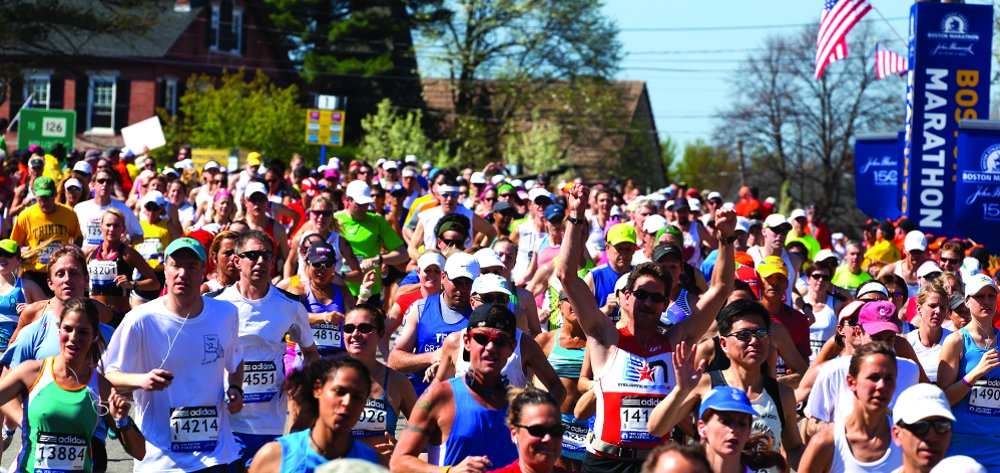Three yellow balloons danced through the air, hovering over the finish line after being released by the bomb blast that brought the 2013 Boston Marathon to a catastrophic close on April 15. We may never know who’d been carrying those balloons that day—the 117th running of the Marathon. But those balloons have come to symbolize the strength of the people of Boston, who’ve been deeply affected by the bombings.
When the unimaginable occurred, medical volunteers—nurses, physicians, medical-records clerks, physical therapists, and many others—were thrust into a war zone. Nurses are trained to provide care in a range of settings. Some of the volunteer nurses in the medical tent were trained to care for critically ill patients in emergency departments (EDs) and intensive care areas; others, for patients in medical clinics; and still others, for long-term care patients. But we all had one purpose at the Marathon: to provide assistance to the runners.
As we arrived that day, we expected to be seeing runners with dehydration, hyperthermia, electrolyte imbalances, muscle cramping, and foot problems. Appropriate supplies and information were available to treat these problems. After we were divided into teams, we headed to the medical tent at the finish line. We were ready.
During the first part of the day, we provided care for many runners. Some recovered after being rehydrated or having their muscles stretched by volunteer physical therapists, massage therapists, or nurses. A little food, a little water, a bit of care and comfort, and they were good to go. Some needed treatment for electrolyte imbalances and dehydration—but this, too, was well within our capabilities.
My last runner before the first bomb blast was one of the Tough Ruckers, a group of military service members marching the 26.2-mile marathon wearing heavy backpacks (rucks) to honor fallen comrades and raise funds for wounded veterans. After finishing, some of the Ruckers came to the medical tent to have their feet and general well-being checked. This was something we were prepared to handle, and I was more than happy to do so. As one of the servicemen waited for the podiatrist to check his feet, I assessed him for signs and symptoms of electrolyte imbalance and dehydration. I was amazed he’d run 26.2 miles in army boots carrying a ruck I couldn’t even pick up. He corrected me, “No, ma’am. I walked 26 miles and ran the last 0.2.”
Just then, I heard a sudden loud noise and felt a vibration shake the ground under me. From the look on the Rucker’s face, I knew he’d heard that sound before. I asked if he’d served overseas; he quietly replied, “Yes.” I tried to allay his fears by telling him we’d be okay. He told me to do my job, and said he was going to do his. In an instant, his job had changed from marching to honor fallen service members to joining his fellow Tough Ruckers helping to secure the area and evacuate the wounded. My job had changed from treating dehydration and sore feet to coping with a disaster none of us could have anticipated.
A flood of injuries
Within minutes, the medical tent was flooded with injured bystanders and runners. Among the first was a young man who’d suffered traumatic amputations of both legs and was covered in blood and soot. We were now in a war zone, and the medical tent had become a makeshift battlefield hospital.
My first thought: Are we prepared to handle these injuries? Many people have asked me if I was afraid or if I thought of leaving the area to get to a safe zone. For a brief moment, I did want to leave the tent—not to flee the area but to go to the finish line to help in any way I could. (I have recent clinical experience in emergency nursing, as well as training in handling trauma victims.) But my team members reminded me that we needed to be prepared for the incoming wounded.
Initial responders on the streets used whatever they could to make tourniquets for the wounded. Many of the injured had deep wounds caused by shrapnel released from the bombs. Some had burns. Several had traumatic amputations of one or both lower legs or such extensive extremity injuries that tourniquets were essential to their survival. Without tourniquets, many of them likely would have died from exsanguination. (See New perspective on tourniquets by clicking the PDF icon above.)
Triaging the wounded
The team in the medical tent immediately established a triage system. As a former ED nurse, I was well versed in triaging and knew which patients required immediate care, which could be managed temporarily in the medical tent, and which we’d have to manage in the tent until the critical or more seriously injured were transported. Ambulances were busy transporting those with more serious injuries.
The response to this disaster was phenomenal. Emergency medical technicians, paramedics, firefighters, police officers, bystanders, and medical volunteers came together quickly and efficiently. The injured were mobilized quickly. Supplies needed in the medical tent were brought in by ambulance crews returning to the tent after taking patients to hospitals.
Tragedy and strength
April 15, 2013 was a day many of us will never forget—a beautiful day that turned into a tragic one. Since then, the city of Boston and the bombing victims have been recovering. That day and the dramatic few days that followed focused the spotlight on the tremendous inner strength of the bombing victims, their families, and the entire city of Boston.
The 118th running of the Boston Marathon will occur on April 21, 2014. I will be there to volunteer again. We all remain Boston Strong.
Kim Giroux is an assistant professor of nursing at Mount Wachusett Community College in Gardner, Massachusetts.


















